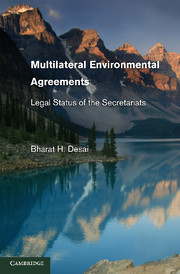Book contents
- Frontmatter
- Contents
- Preface
- Introduction
- 1 Institutionalizing Cooperation
- 2 Multilateral Environmental Regulation
- 3 Nature and Character of Environmental Agreements
- 4 Host Institution Arrangements
- 5 Legal Status
- 6 Conclusions
- Appendices
- Part I Relationship Agreements
- Part II Headquarters Agreements
- IV Headquarters Agreement between UNESCO and France
- V Agreement between the United Nations and the Republic of Kenya regarding the Headquarters of the United Nations Environment Programme
- VI Agreement between the Secretariat of the Convention on Biological Diversity and the Government of Canada concerning the Headquarters of the Convention Secretariat
- VII Agreement between the Federal Republic of Germany and the United Nations concerning the Headquarters of the United Nations Volunteers Programme
- VIII Agreement among the United Nations, the Government of the Federal Republic of Germany, and the Secretariat of the United Nations Framework Convention on Climate Change concerning the Headquarters of the Convention Secretariat
- IX Agreement between the United Nations, the Government of the Federal Republic of Germany, and the Secretariat of the United Nations Convention to Combat Desertification concerning the Headquarters of the Convention Permanent Secretariat
- X Agreement among the Government of the Federal Republic of Germany, the United Nations, and the Secretariat of the Convention on the Conservation of Migratory Species of Wild Animals concerning the Headquarters of the Convention Secretariat
- Index
V - Agreement between the United Nations and the Republic of Kenya regarding the Headquarters of the United Nations Environment Programme
Published online by Cambridge University Press: 05 September 2013
- Frontmatter
- Contents
- Preface
- Introduction
- 1 Institutionalizing Cooperation
- 2 Multilateral Environmental Regulation
- 3 Nature and Character of Environmental Agreements
- 4 Host Institution Arrangements
- 5 Legal Status
- 6 Conclusions
- Appendices
- Part I Relationship Agreements
- Part II Headquarters Agreements
- IV Headquarters Agreement between UNESCO and France
- V Agreement between the United Nations and the Republic of Kenya regarding the Headquarters of the United Nations Environment Programme
- VI Agreement between the Secretariat of the Convention on Biological Diversity and the Government of Canada concerning the Headquarters of the Convention Secretariat
- VII Agreement between the Federal Republic of Germany and the United Nations concerning the Headquarters of the United Nations Volunteers Programme
- VIII Agreement among the United Nations, the Government of the Federal Republic of Germany, and the Secretariat of the United Nations Framework Convention on Climate Change concerning the Headquarters of the Convention Secretariat
- IX Agreement between the United Nations, the Government of the Federal Republic of Germany, and the Secretariat of the United Nations Convention to Combat Desertification concerning the Headquarters of the Convention Permanent Secretariat
- X Agreement among the Government of the Federal Republic of Germany, the United Nations, and the Secretariat of the Convention on the Conservation of Migratory Species of Wild Animals concerning the Headquarters of the Convention Secretariat
- Index
Summary
The United Nations and the Republic of Kenya
Considering that the United Nations General Assembly, by resolution 2997 (XXVII) of 15 December 1972, has established institutional and financial arrangements for the United Nations Environment Programme, and, in response to an offer by the Government of Kenya, has, by resolution 3004 (XXVII) of 15 December 1972, decided that the Environment Secretariat shall be located at Nairobi;
Considering that the Convention on the Privileges and Immunities of the United Nations adopted by the General Assembly of the United Nations on 13 February 1946, to which the Republic of Kenya is a party, is ipso facto applicable to the United Nations Environment Programme;
Considering that it is desirable to conclude an agreement, complementary to the convention on the Privileges and Immunities of the United Nations, to regulate questions not envisaged in that Convention arising as a result of the establishment of the headquarters of the United Nations Environment Programme at Nairobi;
Have agreed as follows:
Article I
Definitions
Section – 1
In this Agreement,
(a) The expression “the UNEP” means the institutional and financial arrangements for the United Nations Environment Programme established by the General Assembly of the United Nations in resolution 2997 (XXVII) of 15 December 1972, and such other institutional and financial arrangements as may from time to time be made for the United Nations Environment Programme.
- Type
- Chapter
- Information
- Multilateral Environmental AgreementsLegal Status of the Secretariats, pp. 231 - 256Publisher: Cambridge University PressPrint publication year: 2010



